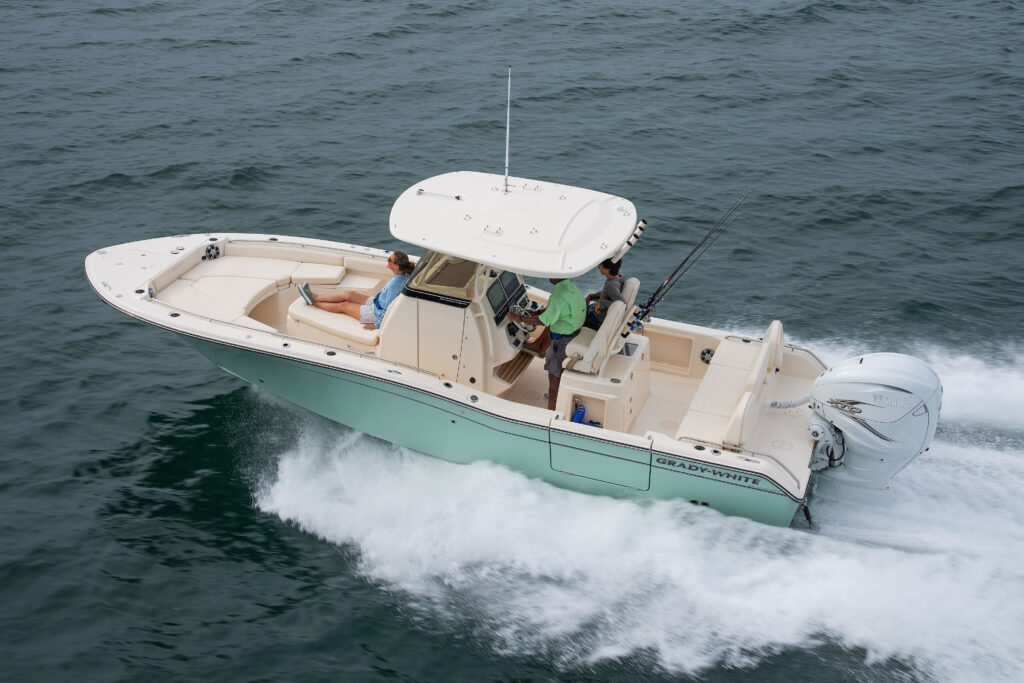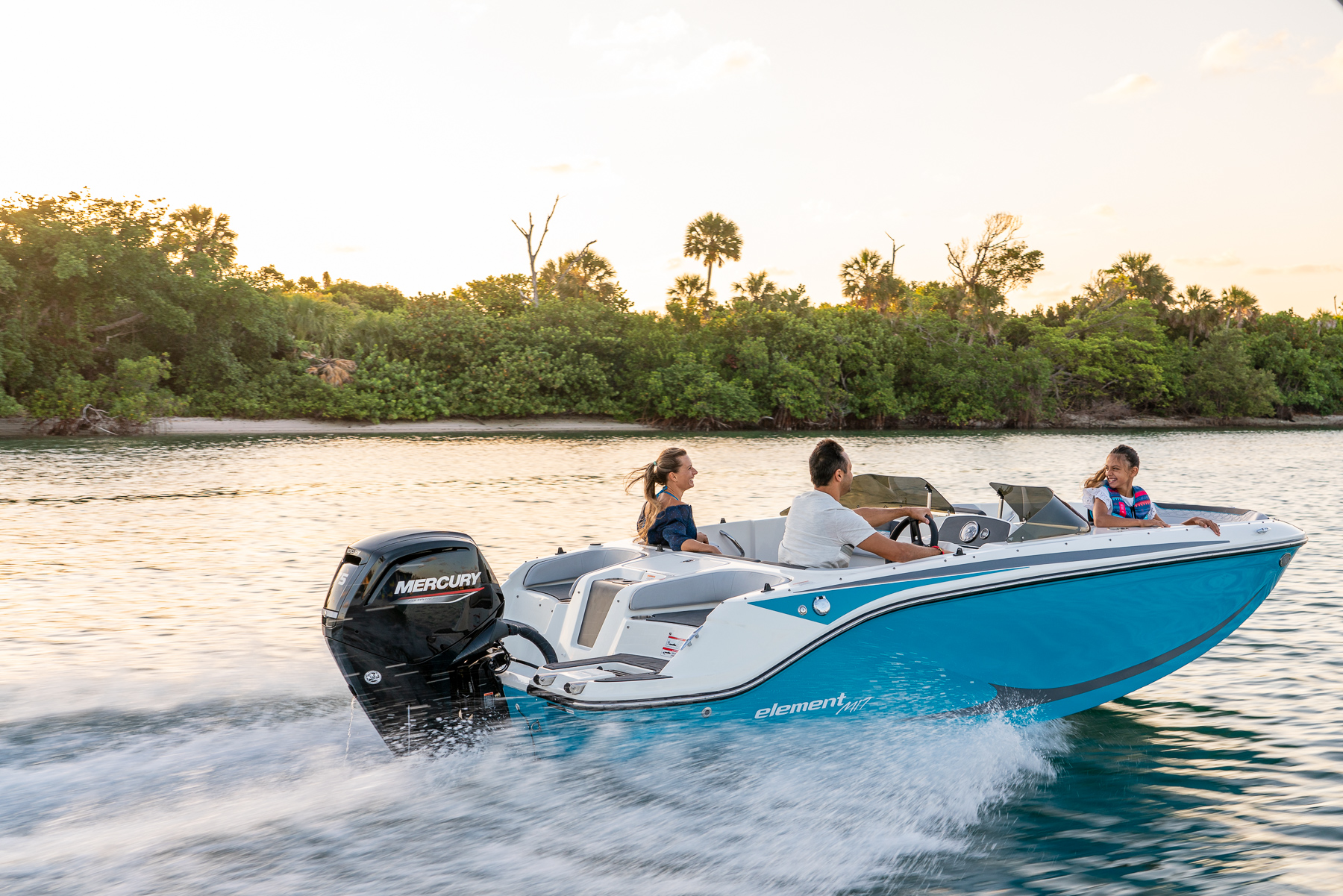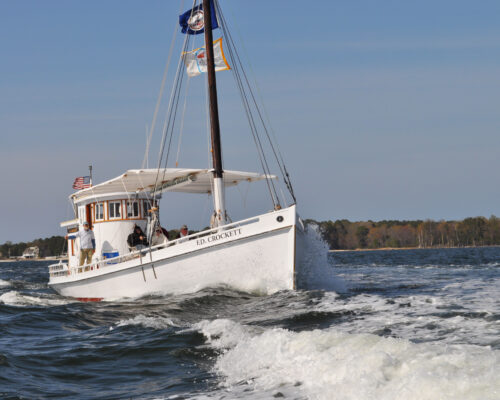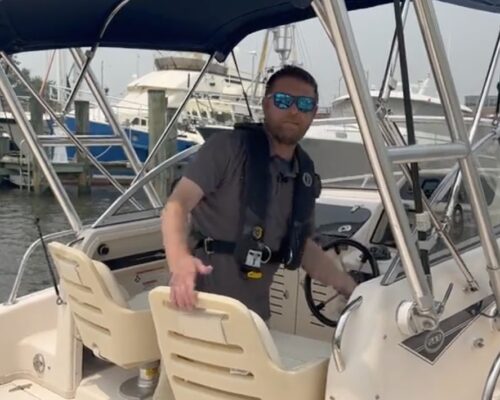In softball or baseball terms, scouts would describe Grady-White’s new 281 Coastal Explorer as a big, athletic, well-conditioned “six-tool player.” This hybrid bay boat can serve as a watersports towboat, a shaded family sandbar oasis, a comfortable race committee platform, a maneuverable shallow-water casting platform, a deepwater podium for chasing breaking fish or jigging wrecks and reefs, or even a weekend explorer of rivers and towns with B&Bs.
The 281 CE starts with a 27’7″ x 9’4″ SeaV2 hull with a sharp bow entry and a relatively shallow 16-degree running bottom. Draft with engine(s) up is only 19″. Figure on Grady-White’s painstakingly strong hull layup, spec’ed by the company’s structural engineer. In our sea trial on North Carolina’s Pamlico River near the company’s Greenville headquarters, that hull showed impeccable manners in conditions varying from drifting in a short, washboard chop up through easy cruising at 20 to 30 knots to tears-in-the-eyes speeds topping out right on 50 knots. Power was a pair of Yamaha’s well-proven 300-hp four-strokes with Helm Master EX Digital Electric Steering and joystick. Optional power is a single 450-hp Yamaha XTO four-stroke, but we’d opt for the twins on this rig. First, they offer extra maneuverability with the full suite of Helm Master EX programs, including autopilot, Set Point, Drift Point and Fish Point. Second, their electronic rigging is exceptionally neat, making for a clean transom platform for moving around when handling lines (both dock- and fishing). Third, fuel efficiency is about the same as with the single big motor, according to Yamaha’s tests.
The hull is classically attractive, with a raised sheer and Carolina flare, but the 281 CE’s magic lies in its intricate and still thoroughly strong and useful deck-and-liner, which takes three days to lay up and laminate properly. Look closely at images of the boat’s interior (or better yet, a finished boat at hand), from bow deck and anchor locker through lounges to the console and the afterdeck. Note that the console is an integral element in the deck layup. Consider what it took to analyze the structural needs and develop specifications for all of the flat surfaces and angles in the layup. Remember that the liner must not only come out of the mold structurally strong but also shaped and sized to accommodate the boat’s human occupants while looking attractive to them. That’s why Grady-White’s design team also includes our friend Christian Carraway, an engineer who specializes in ergonomics and aesthetics, and who came along on our sea trial. His understanding of the whole design process is always valuable for a review like this one.
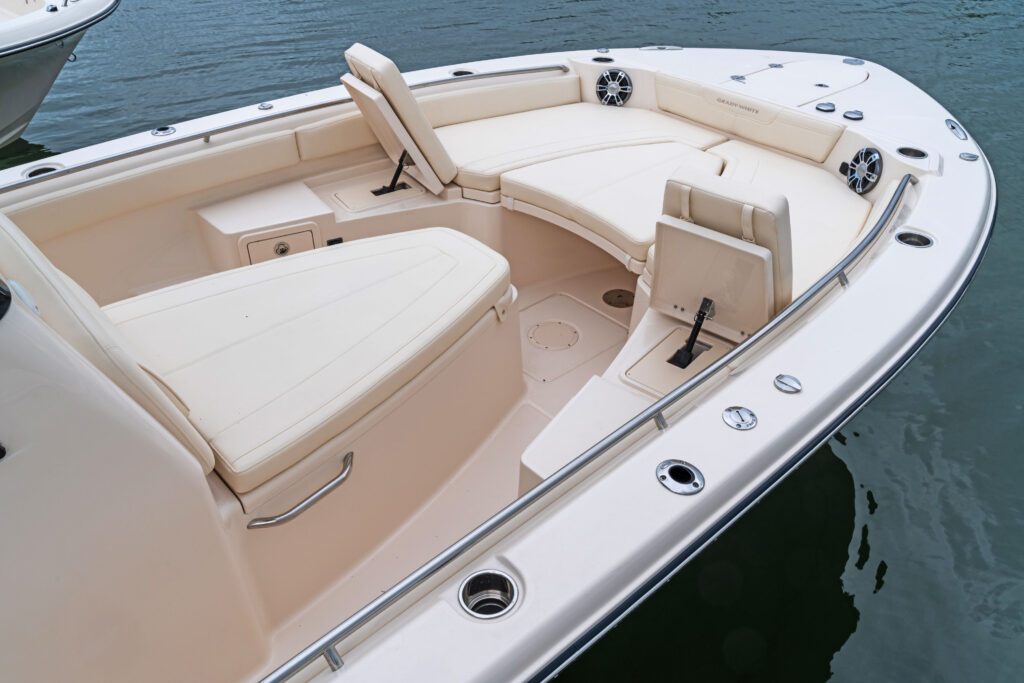
Imagine what it takes to set the fabric package properly into all of the small, narrow recesses in this large part, to add correct amounts of resin, and to squeegee it correctly into the fabric. That is modern composite craftsmanship. One testimony to the strength of the console is that the entire frame and hardtop assembly fastens to it. That feature also means that there is nothing on the deck around the console for a person to trip over.
So much for size, athleticism, and physical condition. As to the towsports tool, either power package is plenty for towing all manner of skis, including bare feet, as well as boards and inflatable toys. A ski arch is optional for a single-engine boat, or a pylon for twins. A sturdy, electrically actuated door in the cockpit’s portside offers great access for swimmers, away from the engines. Its telescoping ladder lives in an adjacent topside compartment that also contains the switch for lowering and retrieving the door. Any water that might splash in runs aft to a large drain in the port transom corner and thence overboard.
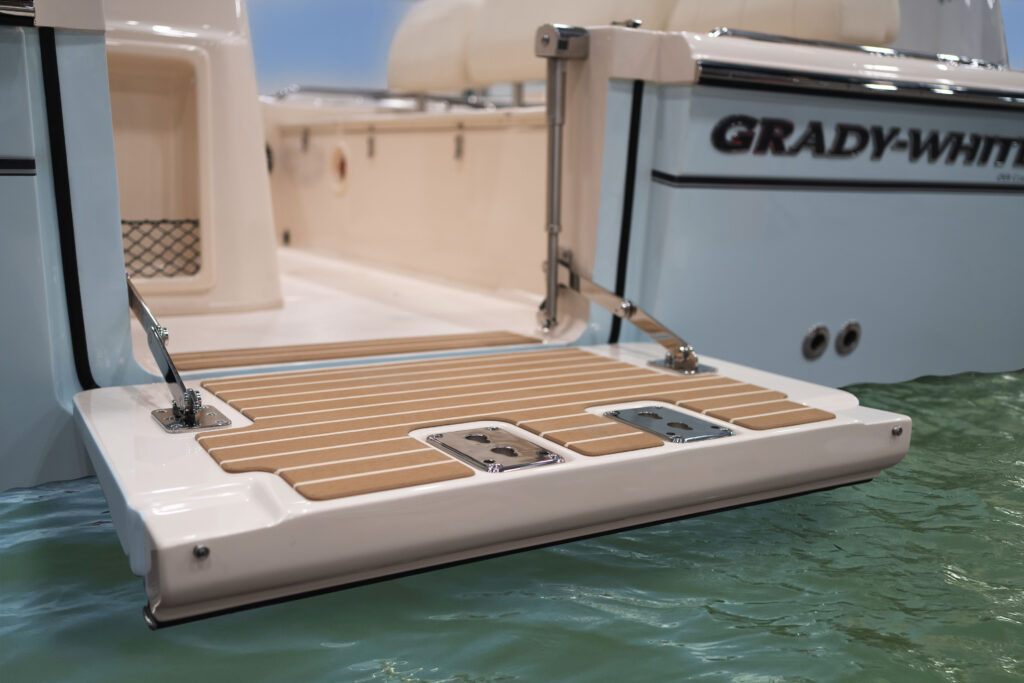
For visiting a beach or sandbar, the 281 CE slides in easily, and deploying twin (dealer-installed) shallow-water anchors at the transom makes it a piece of cake to hold position. A stern shade electrically actuated from the hardtop is optional, as is a bow shade extending from the front of the hardtop and standing on four carbon-fiber poles set in small gunwale sockets. The two cushioned seats along the sides of the bow and the double seat in front of the console are insulated to hold ice, food, and drinks. The aft ends of the bow seats rise on electric rams to create forward-facing lounges.
A table in the center can rise to serve lunch or lower to create a sunpad, along with a crescent-shaped insert that extends from the table to the double console seat. The vented, lighted console offers 63″ of headroom and enough shoulder room for anyone but an NFL linebacker to change clothes or use the standard porcelain toilet. All of these amenities except for the swim door would also be useful for race committee duty at a regatta, along with the full-beam stern seat.
If Saturday morning means shallow water fishing, the 281 CE is ready. Katie Creech, a Pamlico River native turned Grady-White marketing pro, enthusiastically went over the boat’s capabilities while we were on her river. Without cushions, the forward seats, table, and crescent form a vast casting deck. The boat comes pre-wired for a (dealer-installed) 36-volt bow-mount electric motor. The stern seats become a full-width casting deck. Well-plumbed livewells in the center of the stern deck and the leaning post hold plenty of bait.
One of the aforementioned insulated boxes ices the catch. Drawers in the helm’s large seating module hold tackle boxes, and the top of the unit offers a sink and cutting board. Rod holders behind the helm, companion and transom seats, on the after edge of the hardtop, in both gunwales, and under the starboard gunwale provide plenty of secure options for rigs. It wasn’t difficult to see how this setup would work for stalking speckled trout and redfish along shorelines on both sides of the lower Chesapeake as well as in Tangier Sound, the mouth of the Choptank and Eastern Bay.
For working specific spots along bridge pilings, reefs and wrecks from the Chesapeake Bay Bridge-Tunnel between the Virginia Capes to the Bay Bridge off Annapolis, make sure the bow-mount motor is GPS-enabled to hold the boat in position. The helm offers space for a pair of 16″ electronic displays (owner-selected and dealer-installed) that enable the skipper to position the 281 CE precisely for casting and jigging, whether the quarry is drum, cobia, sheepshead or spadefish. Of course, the boat is also perfectly outfitted to anchor over a shell reef for a family panfishing trip seeking croakers, spot and white perch, and rigging it for trolling Spanish mackerel would be easy too.
Cruising? Why not? With either engine package, the 281 CE travels comfortably and efficiently at speeds of 20 to 30 knots with a conservative range of 250-plus nautical miles. Plan weekend explorations up the Bay’s big rivers and research old river towns with attractive B&Bs. From Vienna and Seaford on the Nanticoke, for example, to Smithfield and Hopewell on the James, a boat like this one can open up fascinating but overlooked parts of the Chesapeake.
Bonus tool: At day’s end, re-install the cushions and set the table for sunset cruises. The 281 CE can seat up to ten people between the bow lounges, the front of the console, the helm and the stern deck. That SeaV2 hull may eat up gnarly seas on fishing duty, but it’s a beautifully stable platform idling casually around a harbor or up a creek in the evening.
Wait. That makes her a seven-tool player. Oh, well, weekends on the Chesapeake offer so many opportunities that a boat has to be this versatile to take advantage of them all. Base price for the 281 Coastal Explorer with twin 300-hp Yamahas is $300,000. Nicely equipped with electronics, electric bow-mount motor, and other useful options, figure around $350,000 ready to launch. Chesapeake Grady-White dealers include Tri-State Marine (tristatemarine.com), Deale, Maryland, Norfolk Marine (norfolkmarine.com), Norfolk, Virginia, and Southeastern Marine (southeasternmarine.net), Richmond, Virginia.
CBM Editor-at-Large, educator, guide and author of three quintessential Chesapeake Bay books, Capt. John Page Williams was named a Maryland Admiral of the Bay in 2013.
Grady-White 281 Coastal Explorer
LOA: 27’7″
Beam: 9’4″
Draft: 19” (engines up)
Weight: 5,650 lb. (dry, w/o engine)
Transom Deadrise: 16 degrees (SeaV2 progression)
Bridge Clearance: 7’11”
Fuel Cap: 160 gal
Water Cap: 18 gal
Waste Cap: 10 gal
Livewell Capacity: 18 & 38 gal
Max Power: 600 hp

